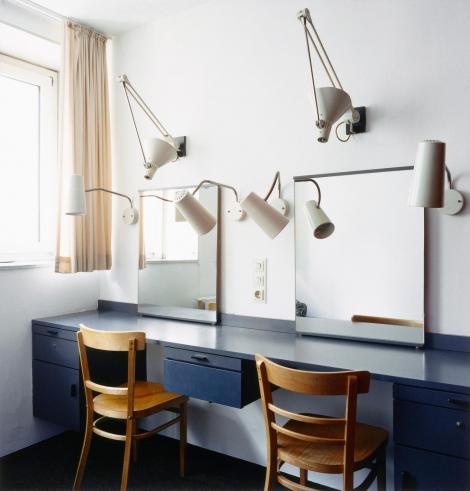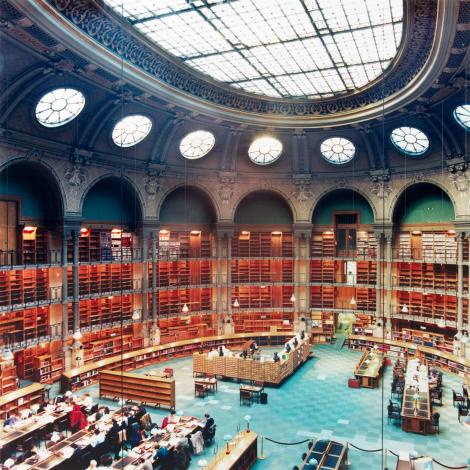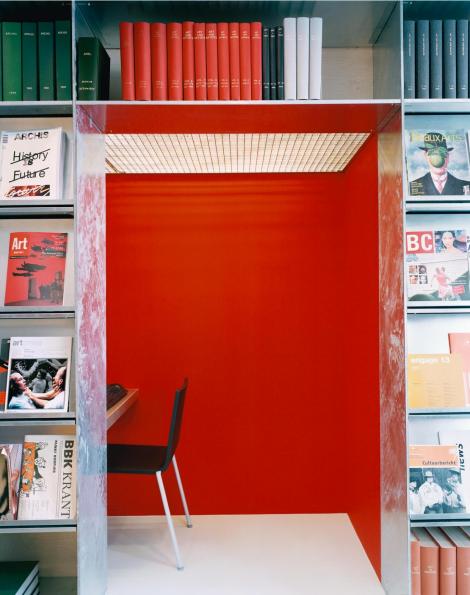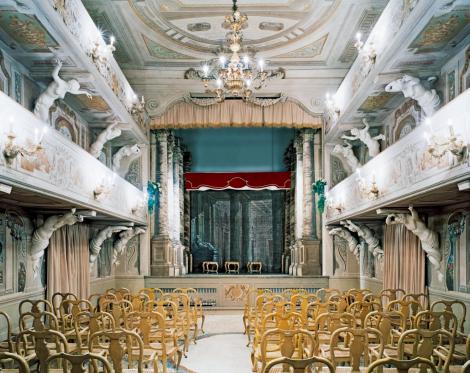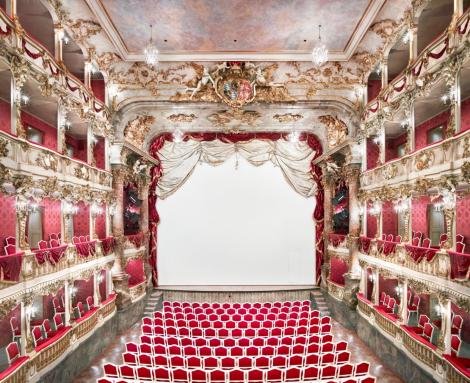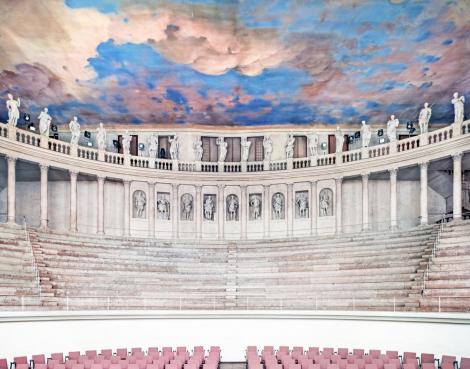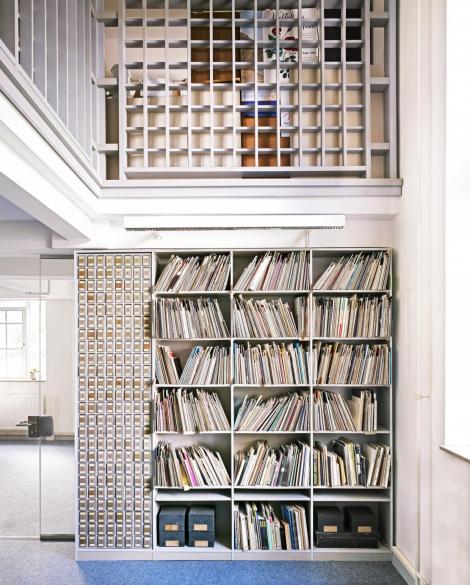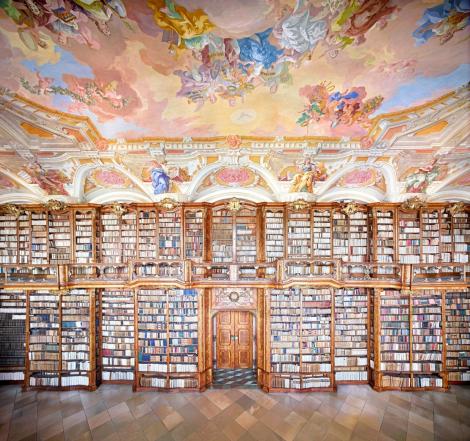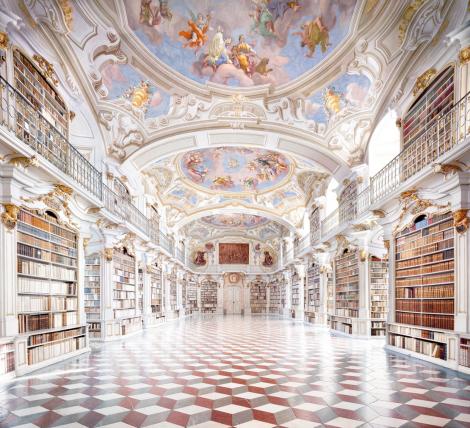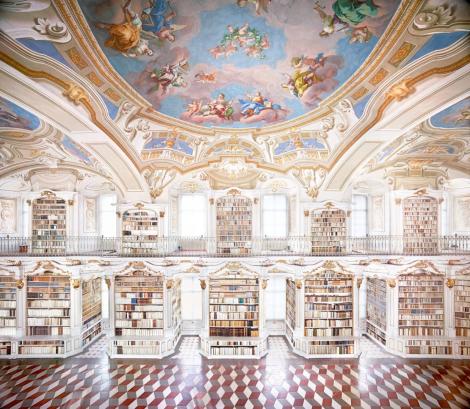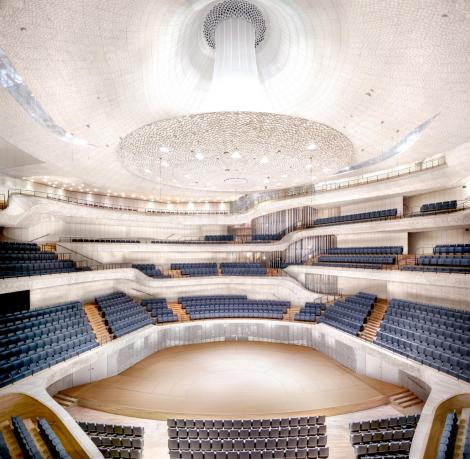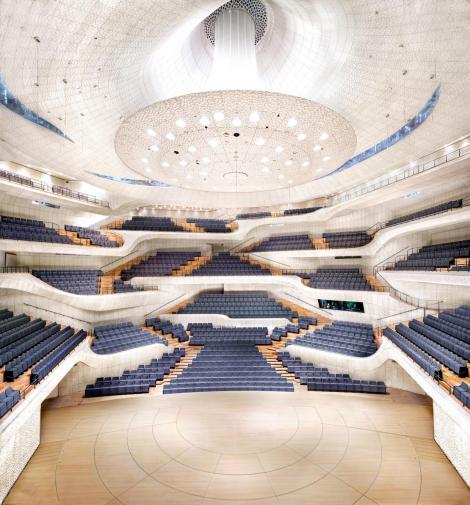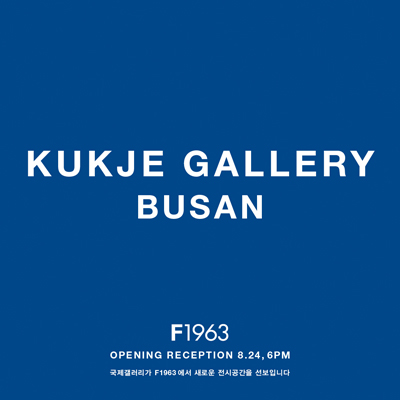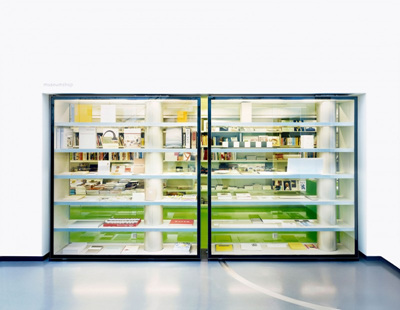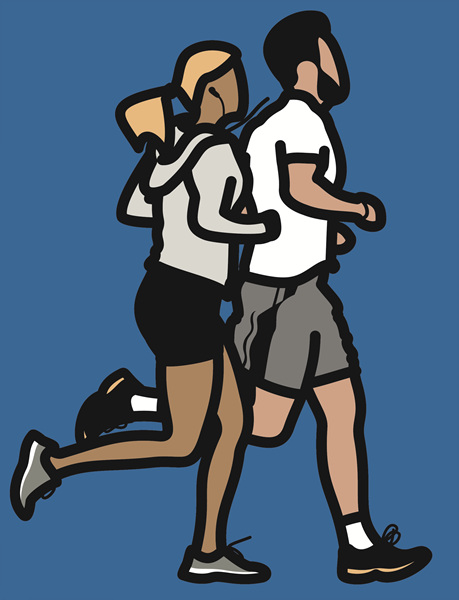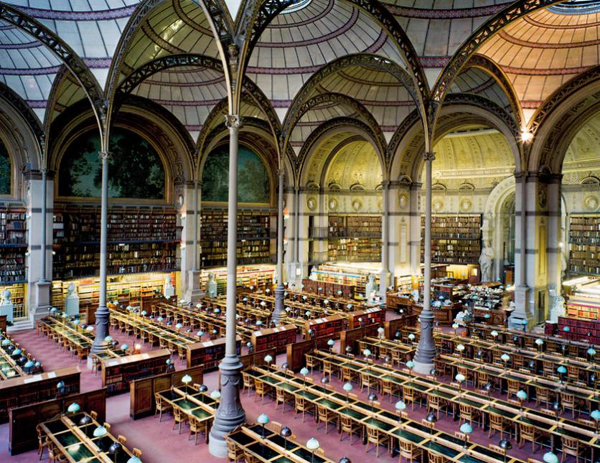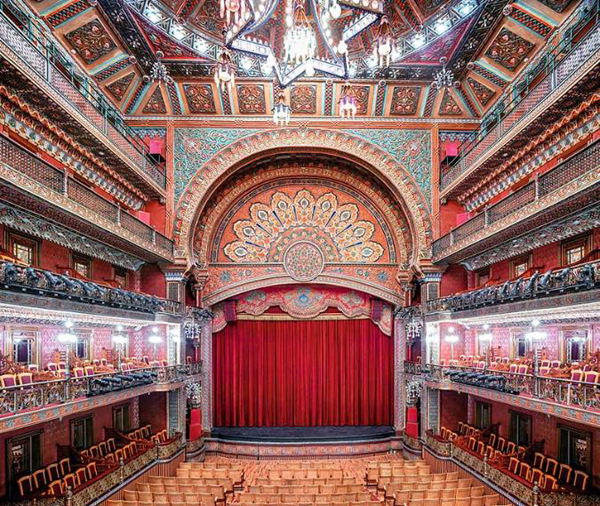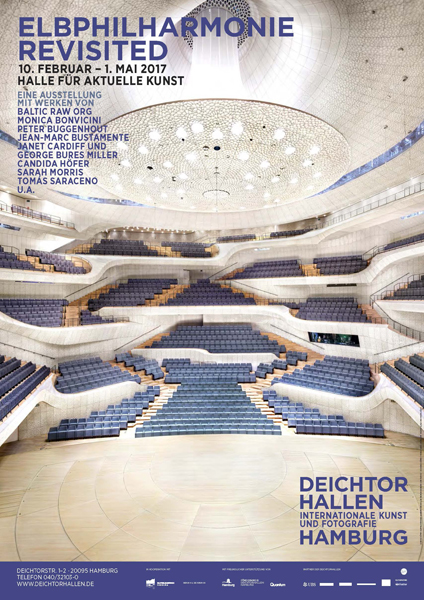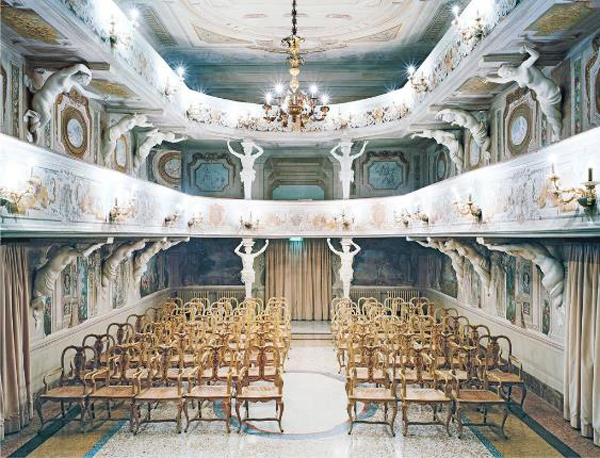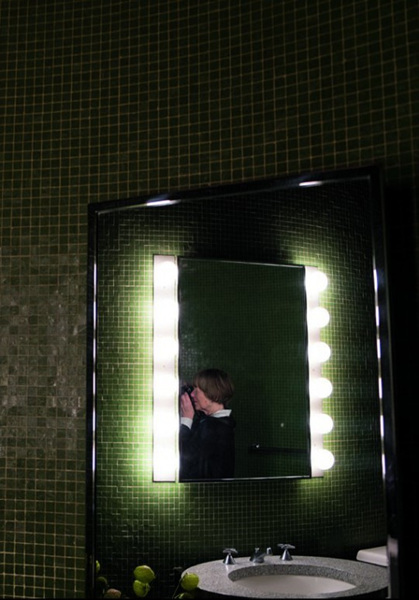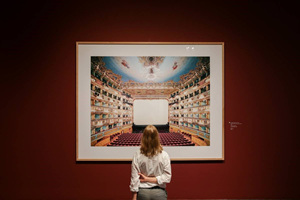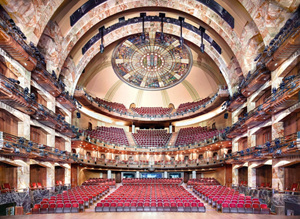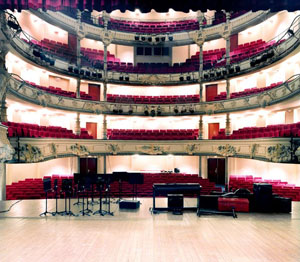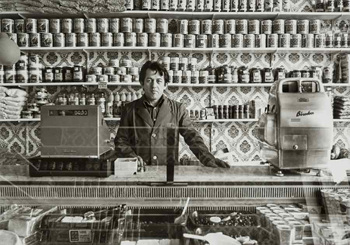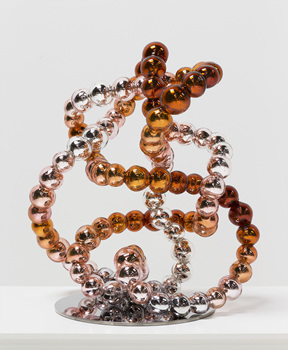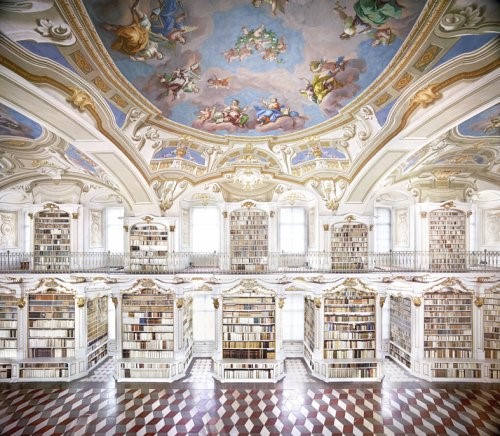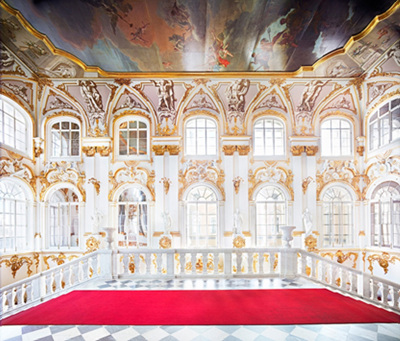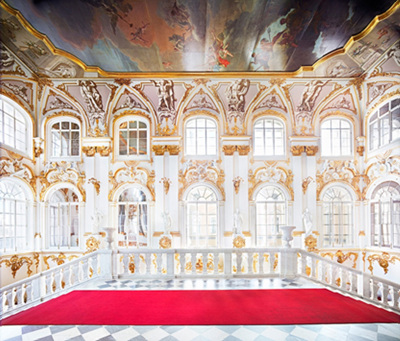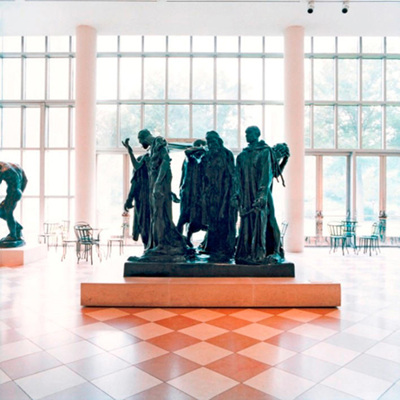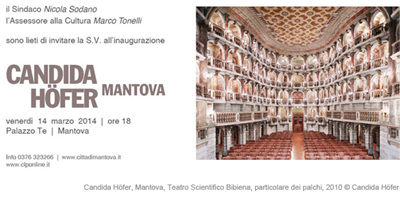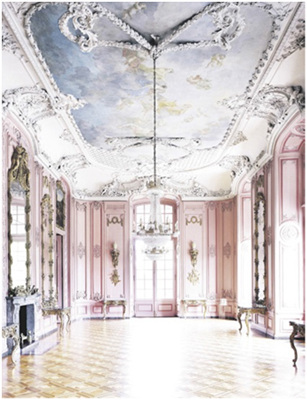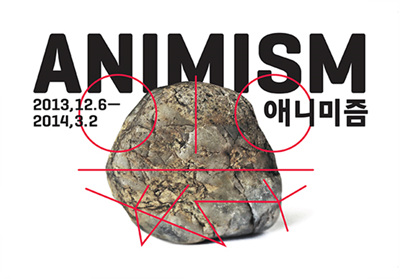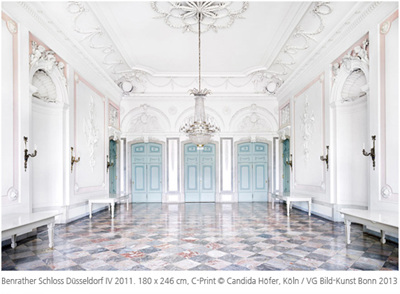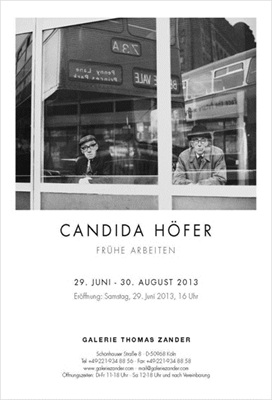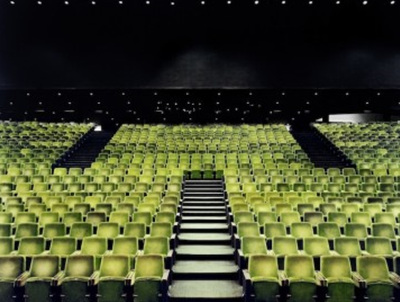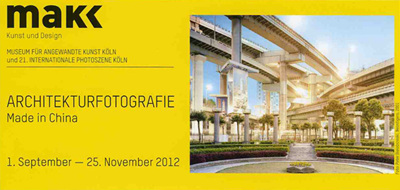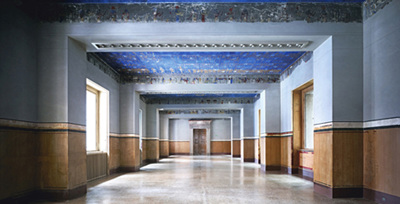 SPACES OF ENLIGHTENMENT | KUKJE GALLERY
SPACES OF ENLIGHTENMENT | KUKJE GALLERY
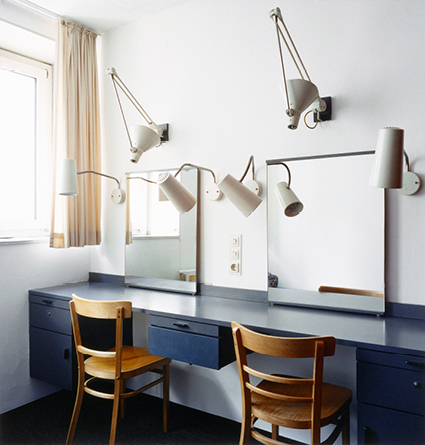
Jul 26, 2018 - Aug 26, 2018
INTRODUCTION
The interiors featured in her photographs include a diverse range of periods and geographies, but each share a common historical function as places designed to assist in “enlightenment.” Primarily known as an intellectual and philosophical movement in Europe during the eighteenth century, the “Enlightenment” was defined by its focus on learning, scientific observation and the pursuit of reason. The ideals of the enlightenment, which have profoundly impacted all aspects of modern society including politics, literature, architecture, and art, begin with this emphasis on human reasoning. More broadly, the concept of “enlightenment” can be understood in a religious context: i.e., Buddhism’s concept of “sudden enlightenment” as well as the symbol of an actual light source often depicted in Christian iconography. What links these references is the idea that a state of enlightenment, or “awakening,” is achieved not only through the accumulation of knowledge but also by a change in perception. It is within this context that Höfer engages her subject, presenting these social spaces as places that facilitate human reasoning and intellectual advancement.
The first floor of the K2 space showcases works that capture the interior spaces of theaters and opera houses in Germany, Italy, Portugal, and Argentina. Beginning with the iconic Düsseldorfer Schauspielhaus, Höfer’s images allow the audience to read into the specific architectural characteristics, along with their historical context. This can be seen in the Teatro di Villa Aldrovandi Mazzacorati, Bologna, a private theater built on the land of an aristocratic family as well as in the Teatro Olimpico Vicenza, a building in which tricks of perspective were used to create an illusion of greater space. Another of Höfer’s subjects, the Teatro Comunale di Bologna, was one of the first municipal theaters in Italy inaugurated with public funds. The theater as a shared venue highlights a series of historical developments leading to the establishment and use of public spaces, marking the expansion of spectatorship with the rise of the middle class during the Age of Enlightenment. These social changes then led to the establishment of civic institutions and the popularization of the kind of performance arts that were previously limited to the aristocracy. Looking closely at Höfer’s images, we can read these transformations in the architectural designs, interpreting changes as reflecting shifts in class structure. For example, the box seats originally designed for the nobility and the parterre section (today known as the “stalls”) designed for the middle class, evolved to include the introduction of seats in the latter and ultimately to the elimination of such strict hierarchical separation in public.
The second floor of the K2 space introduces the interior spaces found in libraries and museums, places focused on the pursuit of learning and aesthetics. Höfer pays particular attention to the Baroque libraries housed in monasteries from the Middle Ages, the National Library of France (Bibliothèque nationale de France), a small bookshelf situated in the hallway of the Kunstakademie Düsseldorf, Villa Borghese, the State Hermitage Museum, and the Julia Stoschek Collection; all of these spaces embody each of their evolving function over time. Together with the collection of books, objects, artworks, wall paintings, and furniture, these sites have cultivated their social and historical status, for which they are recognized today. Since their founding, these spaces have been transformed from being reserved only for the privileged to opening their doors to a democratic public. It is in these locations that untold numbers of artists, historians, and philosophers interacted with the public, bringing about changes in cognition and understanding, inspiring creativity and the subsequent birth of great art. Candida Höfer channels this complex accumulation of cultural and artistic influences, capturing the dynamic energies that remain embedded in their spaces.
The spaces in Candida Höfer’s photography quietly hint at how human presence remains embedded in a space, even when unoccupied. In the series most often classified as her early works, including Liverpool (1968), Höfer chronicles the many faces of the city; in Flipper (1973), she captures spaces with pinball machines throughout Europe. The photographic series Turks in Germany and Turks in Turkey, developed throughout the late 1970s, portray Turkish communities in Germany and Turkey respectively, framing the artist’s foundational interest in the physical and social interactions between spaces and human beings. Beginning in the 1980s, Höfer turned her attention towards “public spaces” such as zoos, art and natural history museums, and libraries, documenting the locations and consequence of human cultural activities. The artist captures these organic relationships between spaces and people, subjects and geographical, spatial environments in her viewfinder. The gradual absence of people in her images came naturally during this process, as the artist came to believe that since a space inherently functions with the aid of people, it is unnecessary to prove its existence by including people in the photographs.
The majority of Candida Höfer’s early works were photographed with a 35mm (compact; handheld) camera, with the exception of when her professor Bernd Becher at the Kunstakademie Düsseldorf recommended a large plate camera. In the late 1990s, Höfer’s transition to using a tripod, a 6x6cm and subsequently a 9x12cm format eventually made large-scale prints possible, further highlighting the pristine structural arrangements and spatial organization captured in her work. This transition allows her audience to slowly absorb the minute details that pervade the space in each image, and recognize that many, if not all, of these distinct components of each venue not only act as distinct man-made symbols, but also as elements that constitute the social space.
Candida Höfer works solely with the natural light and artificial illumination that suffuse each venue within a given time period—refraining from using any additional lighting equipment. The artist peruses each location and establishes her point of view before taking her images; what follows is a careful process of editing and the selection of multiple prints prior to settling on a final product. Each title bears the name of the location, institution, and year of the shoot, and the order of production in Roman numerals should multiple photographs be produced from the same venue. Keeping her interference during the process to a minimum, Höfer places margins between the image and frame, effectively constructing a divide between the space of the viewer and the space that exists behind the glass while simultaneously connecting the two spaces. Such artistic decisions induce her audiences to encounter a portrait of space that is imbued with the vestiges of people, time, and history.
About the Artist
Candida Höfer was born in 1944 in Eberswalde, Germany, a town situated northeast of Berlin. Having expressed interest in photography during childhood, Höfer first began her career at the age of nineteen as an apprentice at a photography atelier that dealt with advertisements, architecture, and fashion. She entered the Kölner Werkschulen (Cologne Academy of Fine and Applied Arts) in 1964 and studied art and photography, and worked as a freelance photographer upon graduation. She later attended the Kunstakademie Düsseldorf, one of the most influential European educational institutions at the time in 1973, where she initially studied film under Ole John. In 1976 she was accepted into Bernd Becher’s first photography class, studying alongside contemporaries Axel Hütte (1976 – 1981), Thomas Struth (1976 –1980), Thomas Ruff (1978 – 1985), Tata Ronkholz (1978 – 1985), Petra Wunderlich (1985 – 1988), and Andreas Gursky (1981 – 1987)—later collectively referred to as the first generation of the “Becher class.” Having already been the subject of gallery exhibitions in the late 1970s, Candida Höfer has spent decades expanding and redefining the boundaries of her practice. She not only photographs the interior spaces of public venues, but also conducts serial projects with specific subjects such as On Kawara’s Date Paintings and the twelve casts of Auguste Rodin’s The Burghers of Calais, documenting how they are placed in their respective collections, along with photographing the interiors and exteriors of the architectural feats of Herzog & de Meuron.
Widely exhibited around the world through innumerable solo and group exhibitions, Candida Höfer’s works have been shown at documenta11 (2002) in Kassel, Germany, as well as having represented Germany alongside Martin Kippenberger at the national pavilion of the 50th edition of La Biennale di Venezia (2003) in Italy. Höfer was the recipient of the Outstanding Contribution to Photography award by the Sony World Photography Awards in April of 2018. Her works can be found in major collections including the Museum of Modern Art in New York, the Centre Pompidou in Paris, the Bibliothèque nationale de France, the Museum Ludwig in Cologne, the Moderna Museet in Stockholm, the Museo Centro de Arte Reina Sofia in Madrid, Museo Guggenheim Bilbao, the National Museum of Modern and Contemporary Art in Seoul, the Rubell Family Collection in Miami, and the Friedrich Christian Flick Foundation in Zürich. Candida Höfer currently resides and practices in Cologne.
국제갤러리는 현대 사진의 지평을 넓혀온 세계적인 작가 칸디다 회퍼(Candida Höfer)의 개인전 《Spaces of Enlightenment》를 7월 26일부터 8월 26일까지 개최한다. 국내에서 네 번째로 열리는 이번 개인전은 지난 50여 년간 사진이라는 매체를 통해 공간과 인간을 사유해 온 칸디다 회퍼의 작품들 중에서도 1990년대 말부터 근래까지 촬영된 ‘공연장(Theatre, Opera House)’, ‘도서관(Library)’, ‘미술관(Museum, Collection)’ 등 특정 기관의 공간에 주목한다.
이번 《Spaces of Enlightenment》전에서 선보이는 작품들의 내부 공간은 다양한 시대와 지역을 아우르는 동시에 모두 인간의 ‘깨달음(enlightenment)’을 가능하게 한 장소다. 소위 18세기 서구 계몽주의 사상으로 알려진 “Enlightenment”는 인간을 포함해 자연, 사회, 정치에 대한 객관적 관찰과 보편적인 이해를 바탕으로 한다. 근대 철학, 정치, 문학, 건축, 예술 등 사회 전반에 폭 넓은 영향을 미친 계몽사상은 합리적으로 생각하는 인간의 힘, 즉 이성의 빛에서 출발한다. ‘enlightened(깨우친, 계몽된, 개화된)’라는 단어의 의미와 더불어 불교의 돈오(頓悟)로 해석되거나 빛으로 도상화되기도 하는 ‘깨달음’의 행위는 단순한 지식의 축적에서 비롯되기보다 연역적 사고와 경험을 통한 인식의 변화, 즉 일종의 ‘깨어나기’로 볼 수 있다. 이러한 맥락에서 이번 전시에 소개된 작품들 속 공간은 사유의 단초를 제공하고 인식의 변화를 일깨운 사회적 장소들로 읽힌다.
국제갤러리 K2의 1층은 뒤셀도르프 시립극장(Düsseldorf Schauspielhaus)을 시작으로 독일, 이탈리아, 포르투갈, 아르헨티나의 극장과 오페라 하우스의 내부 공간을 담은 작품으로 구성된다. 이들 공간은 다양한 건축 양식과 시대적, 사회적 변화를 가늠하게 한다. 예컨대 명문가의 사유지에 마련되었던 개인 극장(Teatro di Villa Aldrovandi Mazzacorati, Bologna), 닫힌 공간을 더 넓고 깊게 보이도록 원근법을 이용한 설계 방식(Teatro Olimpico Vicenza), 공공 기금을 통해 건립되고 지방자치단체가 운영하는 공설 극장(Teatro Communale di Bologna)은 왕족과 귀족에 국한되었던 음악과 청중의 역할이 중간계급의 부상과 맞물려 확대되고, 나아가 공적 기관의 설립 및 대중화로 이어진 일련의 역사를 대변한다. 귀족들이 독점하다시피 한 박스석과 일반 관객들이 대부분 서서 관람하던 무대 정면의 파르테르(오늘날의 스톨석)의 구성에서 이후 파르테르에 의자가 설치되고 객석의 계급적 분할 자체가 사라지는 변화는 특히 주목할 만 하다.
K2 2층에서는 인간의 지적, 심미적 추구의 장으로 한데 묶일 수 있는 도서관과 미술관의 공간들이 소개된다. 중세 수도원 내 바로크 양식의 도서관, 프랑스국립도서관, 뒤셀도르프 아카데미 내 복도에 놓인 작은 서가, 빌라 보르헤스, 에르미타주미술관과 율리아 슈토셰크 컬렉션 등 작품 속 공간들은 오랜 시간에 걸쳐 이 곳에 머물고 스쳐간 이들과의 관계를 통해 사회적, 인문학적 장소로써의 역할을 획득하였고, 장서와 미술품, 벽화, 가구 등의 구성과 맥락으로 고유한 개성을 부여 받아왔다. 특권계층을 위한 곳에서 민주화된 문화의 장소로 전환된 이러한 공간들은 무수한 교류와 이를 통한 인식 변화가 깨달음으로, 나아가 위대한 창작의 순간으로 이어졌음을 암시한다. 칸디다 회퍼는 이 모든 것이 축적된 공간들을 그만의 긴 호흡으로 작품에 고스란히 담아낸다.
칸디다 회퍼의 사진 속 공간들은 인간의 자취를 담고 있다. 영국 리버풀의 도시 풍경(Liverpool, 1968), 유럽 도처에 핀볼 기계가 놓인 공간의 모습(Flipper, 1973)과 1970년대 후반까지 진행된 독일 내 터키 이주민들(Turks in Germany), 그리고 자국 내의 터키인들(Turks in Turkey) 등 시기상 초기작으로 분류되는 작품들은 공간과 인간의 물리적, 사회적 상호 작용에 대한 작가의 관심을 방증한다. 작가는 1980년대부터 동물원, 미술관, 박물관, 도서관과 같은 ‘공적 공간’으로 시선을 옮기는데, 이는 인간의 문화 활동이 이루어지고 그 산물로 존재하는, 나아가 사회 구성원들에 의해 형성된 공간이다. 작가는 이러한 공간과 인간, 그리고 특정 피사체와 다양한 지리적, 공간적 환경과의 유기적 관계를 뷰파인더에 담아낸다. 이 과정에서 서서히 부재하게 된 인간의 존재는 공간이란 본래 인간에 의해 기능하는 곳이므로 굳이 그들을 포함시킴으로써 그러한 사실을 입증할 필요가 없다는 점에서 매우 자연스러운 변화였다.
뒤셀도르프 아카데미 재학 시절 스승의 권유로 대형 카메라를 시도했던 특정 시기를 제외하고는 대부분 35mm 카메라(compact camera)로 촬영된 초기 작업들은 작은 사이즈로만 인화가 가능하였다. 1990년대 말, 삼각대와 6x6cm, 9x12cm 포맷을 사용하면서부터 가능해진 대형 프린트는 공간에 배치된 사물들의 배열 방식을 더욱 뚜렷하게 드러낸다. 이로 인해 관객들은 이미지 상의 공간 내 디테일들을 찬찬히 들여다볼 수 있으며, 이내 뚜렷한 개별성을 지닌 모든 구성 요소들이 인간에 의해 만들어진 기호적 장치로 작용할 뿐 아니라 하나의 사회적 장소를 이루고 있음을 지각하게 된다.
칸디다 회퍼는 주어진 시간 내에 장소 자체에 깃든 자연광과 인공 조명으로만 작업하며 일체의 추가 조명을 사용하지 않는다. 그는 공간을 탐색하고 구도를 잡은 뒤 셔터를 누르고, 여러 차례의 인화와 선별 작업을 거쳐 최종 프린트를 선정하며, 이 프린트에 촬영된 기관명, 년도, 동일 장소일 경우 로마자로 그 순서를 기입한 제목을 부여하는 등 최소한으로 개입한다. 아울러 이미지와 프레임 사이에 여백을 넣어 현재와 작품 속 공간을 분리시키는 동시에 서로를 연결시킴으로써 관객은 인간, 시간, 역사가 함께 호흡하는 공간의 초상을 마주하게 된다.
작가 소개
칸디다 회퍼는 1944년 베를린 근교 에베르스발데에서 태어났다. 이미 유년기에 사진에 대한 관심을 표명한 그는 19세에 광고, 건축, 패션 사진을 다루는 사진 아틀리에에서 견습 생활을 했다. 1964년 쾰른 베르크슐레에서 예술과 사진을 전공한 후에는 프리랜서 사진가로 활동하였다. 1973년 당시 유럽 내 가장 영향력 있는 교육기관이었던 뒤셀도르프 아카데미 영화과에서 올레 욘(Ole John)에게 수학하였다. 1976년 베른트 베허(Bernd Becher)가 개설한 사진학과에 입학하여 1982년 졸업 전까지 “베허 학파” 1세대로 일컬어지는 악셀 휘테(Axel Hütte, 1976-81), 토마스 스투르트(Thomas Struth, 1976-80), 토마스 루프(Thomas Ruff, 1978-85), 타타 론크홀즈(Tata Ronkholz, 1978-85), 페트라 분더리히(Petra Wunderlich, 1985-88), 안드레아스 구르스키(Andreas Gursky, 1981-87) 등과 함께 수학하였다. 이미 1970년대 후반부터 갤러리 전시를 갸졌던 칸디다 회퍼는 다양한 공적 기관의 공간들은 물론 온 카와라의 날짜 회화(Date Paintings) 및 로댕의 칼레의 시민(The Burghers of Calais) 12개 에디션과 같은 특정 피사체가 소재한 공간, 헤르초크 앤 드 뫼롱(Herzog & de Meuron)이 설계한 건축물 내, 외부를 담으며 작업의 반경을 넓혀왔다.
전세계 유수의 미술관과 갤러리에서 수많은 개인전과 그룹전을 선보인 칸디다 회퍼는 2002년 제 11회 카셀 도큐멘타에 참여, 2003년 제 50회 베니스 비엔날레에서 마틴 키펜베르거(Martin Kippenberger)와 공동으로 독일관을 대표했으며, 2018년 소니 월드 포토그래피 어워드의 사진공로상(Outstanding Contribution to Photography)을 수상한 바 있다. 주요 소장처로는 뉴욕현대미술관, 파리 퐁피두센터, 프랑스국립도서관, 쾰른 루트비히미술관, 스톡홀름 근대미술관, 마드리드 레이나소피아국립미술관, 빌바오 구겐하임미술관, 국립현대미술관, 루벨 컬렉션, 프릭 컬렉션 등이 있다. 작가는 현재 쾰른에 거주하며 활발하게 작품 활동을 하고 있다.
WORKS
|
Düsseldorfer Schauspielhaus I 1997 |
BNF Paris XXVII 1998 |
|
|
Van Abbemuseum Eindhoven V 2003 |
Van Abbemuseum Eindhoven VI 2003 |
|
|
Teatro di Villa Mazzacorati di Bologna I 2006 |
Cuvilliés-Theater München II 2009 |
|
|
Teatro Olimpico Vicenza I 2010 |
Kunstakademie Düsseldorf III 2011 |
|
|
Augustiner Chorherrenstift Sankt Florian III 2014 |
Benediktinerstift Admont II 2014 |
|
|
Benediktinerstift Admont III 2014 |
Elbphilharmonie Hamburg Herzog & de Meuron Hamburg II 2016 |
|
|
Elbphilharmonie Hamburg Herzog & de Meuron Hamburg X 2016 |
INSTALLATIONS
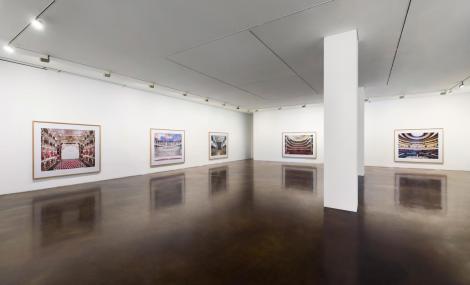
|
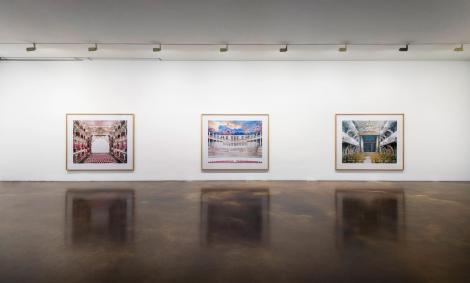
|
|
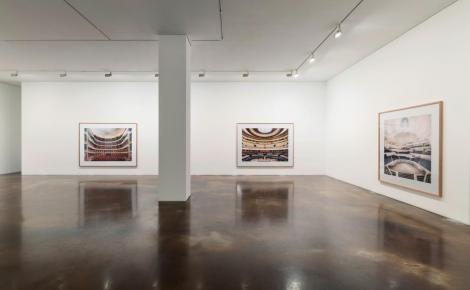
|
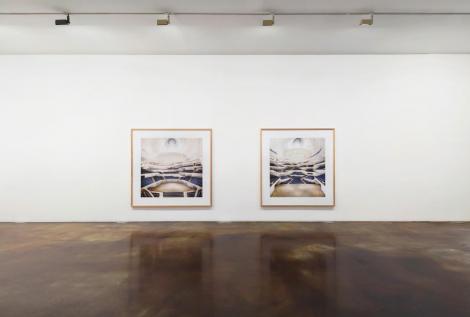
|
|

|
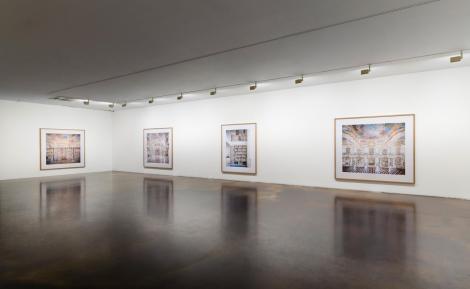
|
|
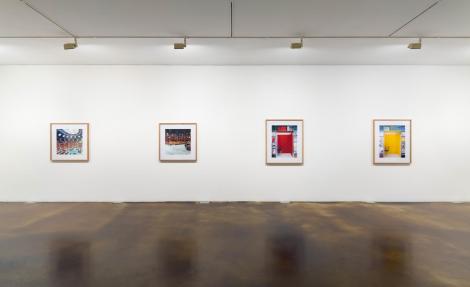
|
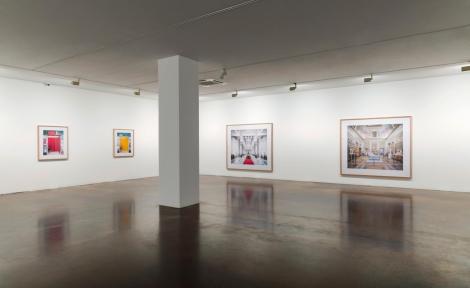
|
|
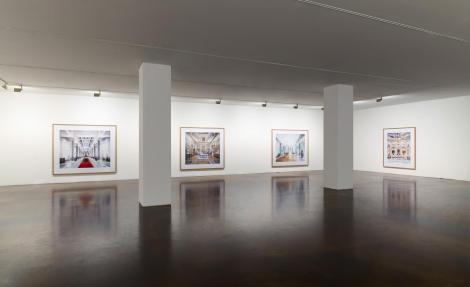
|
VIDEOS
|
Installation Video |
Teaser Trailer |
|
MEDIA COVERAGE
일간지
월간지
주간지/웹
